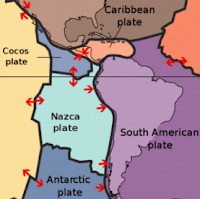Puyehue ("poo-yay-way") volcano in the Chilean Andes of South America started erupting last week on June 3. This area had a small eruption in 1990 but nothing major since 1960. It's part of a complex of volcanoes, called the Puyehue-Cordón Caulle Volcanic Complex (PCCVC), located almost 1,000 km (620 miles) south of Santiago (40°35'25"S, 072°07'02"W).
Due to the sharp increase in seismicity (earthquakes) in the area, geophysicists were monitoring the volcano and were able to issue a warning that it was about to erupt.
There are some amazing images over at the Boston Globe's The Big Picture and The Atlantic's In Focus with Alan Taylor. Check them out.

The ash plume reached of 10 km (6 mi) into the sky. As the ash was carried eastward, by the prevailing winds, it settled like snow up to 30 cm (1 ft) thick on the ground in places.
Airports as far away as Buenos Aires in Argentina were closed down as the ash clouds drifted out over the Atlantic Ocean. Here's the volcanic plume as seen from NASA's Aqua satellite on June 4.
One neat thing that volcanic eruptions can do is trigger lightning. The ash particles rising up through the atmosphere generate static charges (just as water and ice do in the updrafts of thunderstorms). Looks like the start of Armageddon!
The geologic details of the Puyehue-Cordón Caulle Volcanic Complex (PCCVC) are, to use the same word twice in a slightly different way, complex. I'm not familiar with the details beyond the facts that the area has had a complicated history of eruptions along a large fault zone of a wide variety of magma compositions dating back some 300,000 years (well within the Pleistocene Ice Age).
The ultimate cause of volcanism in Chile is due to subduction of a plate of oceanic crust called the Nazca Plate. As the basaltic seafloor subducts beneath the western coast of South America, it partially melts, magma rises and mixes with the overlying granitic continental crust, and forms volcanoes.
Here's Puyehue volcano in calmer times in Parque Nacional Puyehue (Puyehue National Park). Looks like a beautiful place when it's not trying to kill you!










A useful summary with great pictures and useful link. Thank you, Bill.
ReplyDelete